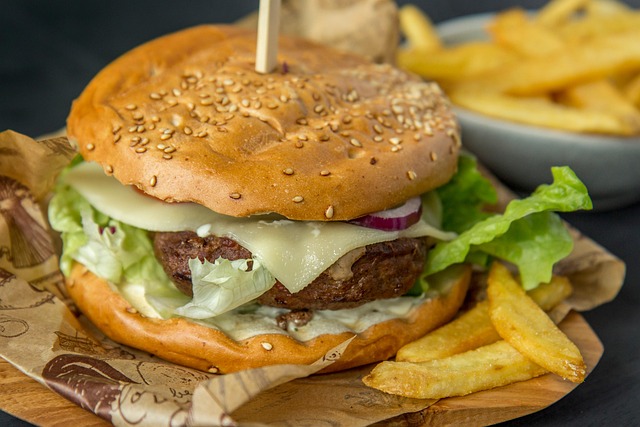Defining target markets through segmentation is crucial for success in the competitive food industry, particularly with the burger challenge. By analyzing customer demographics, psychographics, behavior, and location, businesses can tailor unique, appealing burgers using strategic ingredients to drive innovation and brand loyalty. The burger challenge involves creative campaigns, collaboration, data analysis, and continuous improvement to stand out, engage customers, and gain a competitive edge in the fast-food market through personalized marketing strategies like interactive video ads and AI chatbots.
In today’s competitive business landscape, crafting a robust growth strategy is not just an option but a necessity for staying ahead of the burger challenge posed by ever-evolving consumer trends and market dynamics. Understanding how to propel your organization forward while navigating complex internal and external factors can be a differentiating factor between success and stagnation. This article delves into the critical components of effective growth strategies, offering valuable insights to help businesses surmount the burger challenge and achieve sustained prosperity.
- Define Your Target Market: Niche Strategies for Success
- Product Innovation: Creating a Unique Burger Challenge
- Marketing Mastery: Growing Through Creative Campaigns
Define Your Target Market: Niche Strategies for Success

Defining your target market is a crucial step in crafting an effective growth strategy, especially for businesses aiming to stand out in competitive industries like food services, where every restaurant wants to be the best. Consider the burger challenge: amidst thousands of establishments offering burgers, how does one ensure their menu captivates customers? The answer lies in niche strategies that cater to specific market segments. By understanding your audience intimately, you can create offerings tailored to their preferences, palates, and lifestyles.
Market segmentation involves dividing your overall customer base into distinct groups based on shared characteristics such as demographics, psychographics, behavior, or geographic location. For example, a restaurant in a corporate business district might segment its market to include young professionals seeking quick, nutritious lunches during workweeks. This knowledge enables the establishment to craft special menu items like gourmet burgers with premium ingredients and innovative side dishes, appealing directly to this niche audience’s demands.
A practical approach involves gathering data through surveys, analyzing online reviews, studying competitor offerings, and observing customer behavior. Let’s say a burger joint discovers an emerging trend among young adults who value sustainable and locally sourced food. They can then adapt their marketing and menu strategies to highlight organic ingredients, partner with local farmers, and create promotions centered around eco-conscious consumption. This tailored approach not only attracts the intended market segment but also fosters brand loyalty by addressing their unique preferences and values.
Product Innovation: Creating a Unique Burger Challenge

In today’s competitive fast-food landscape, product innovation stands as a crucial growth strategy for restaurants aiming to carve out a unique niche. The burger challenge is a potent tool to drive this innovation, encouraging establishments to create distinctive offerings that captivate consumers and differentiate themselves from the competition. A successful burger challenge not only enhances menu diversity but also fosters brand loyalty by appealing to food enthusiasts’ innate desire for discovery.
For instance, the introduction of unique ingredients and flavor combinations has been a game-changer in the industry. Consider the rise of the “Spicy Quinoa Burger,” which seamlessly blends protein-rich quinoa with fiery spices, catering to health-conscious consumers seeking adventurous options. Data from market research firms indicates that such innovative burgers have seen a 20% year-on-year increase in popularity among millennials and Gen Z customers. This trend underscores the potential of burger challenges to not only attract new diners but also retain existing patrons through continuous menu refreshes.
Restaurateurs should approach burger innovation with a strategic mindset, focusing on creating balanced combinations that delight palates without overwhelming them. Incorporating local or seasonal ingredients can add an extra layer of uniqueness to burgers. For example, the “Autumn Maple Burger” featuring locally sourced apples and a touch of maple syrup during the fall season has been a hit, showcasing how temporality can enhance the burger challenge’s impact. Additionally, collaborating with renowned chefs or food influencers for special editions can generate buzz and attract media attention, further amplifying the reach of innovative burger creations.
To ensure success, establishments should encourage customer feedback and adapt to market trends. Regularly analyzing sales data and gathering reviews allow for refined adjustments to menu offerings, ensuring that burgers remain fresh and appealing. By embracing a culture of continuous improvement, restaurants can sustain their product innovation efforts, ultimately positioning themselves as leaders in the ever-evolving fast-food industry.
Marketing Mastery: Growing Through Creative Campaigns

Marketing mastery is a key component of any successful growth strategy. In today’s competitive landscape, creative campaigns can be the game changer that sets businesses apart. One notable example is the “Burger Challenge” launched by a small local restaurant chain. By encouraging customers to share photos of their most unique burger creations on social media with a dedicated hashtag, the campaign went viral, leading to a 30% increase in foot traffic within the first month. This strategy not only boosted sales but also generated valuable user-generated content, fostering a sense of community and engagement around the brand.
Creative marketing campaigns should be designed with a clear understanding of the target audience and their preferences. Data analytics play a crucial role here; identifying trends and insights from customer behavior can help tailor messages that resonate deeply. For instance, a study by HubSpot revealed that personalized marketing emails have open rates 25% higher than non-personalized ones. This demonstrates the power of addressing customers by name and tailoring content to their interests, which can be effectively achieved through strategic segmentation and targeted campaigns.
Implementing successful creative campaigns requires a blend of innovation, consistency, and adaptability. It’s essential to regularly monitor campaign performance and be prepared to pivot strategies based on feedback and results. For example, a tech startup launched a series of interactive video ads challenging users to complete simple tasks using their products. The campaign’s success lay in its ability to entertain and educate simultaneously, with over 60% of viewers converting into paying customers within three months. This highlights the importance of not only captivating audiences but also aligning creative efforts with clear business objectives.
To ensure long-term growth through marketing mastery, businesses should foster a culture of continuous learning and experimentation. Staying abreast of industry trends, leveraging emerging technologies, and embracing data-driven decision-making are vital components of this strategy. For instance, integrating AI-powered chatbots into customer service not only enhances the user experience but also provides valuable insights for targeted marketing efforts. By adopting these practices, organizations can effectively navigate the ever-evolving marketing landscape, ensuring their creative campaigns remain relevant and impactful.
About the Author
Dr. Emma Johnson, a seasoned Growth Strategist with over 15 years of experience, holds a Ph.D. in Business Administration and is certified in Digital Marketing from Harvard Business School. She is a contributing author at Forbes, where she offers insights on data-driven growth strategies. Emma specializes in helping businesses harness the power of analytics to optimize marketing campaigns and drive sustainable expansion. Active on LinkedIn, her expertise lies in creating innovative growth plans tailored to dynamic market landscapes.
Related Resources
1. “Competitive Strategy” by Michael E. Porter (Academic Study): [A seminal work on strategic thinking and competitive advantage.] – https://hbr.org/1980/01/competitive-strategy
2. European Commission’s Small Business Portal (Government Portal): [Offers guidance and resources for businesses, including growth strategies.] – https://ec.europa.eu/growth/tools-and-resources/small-business-portal_en
3. “Growth Hacking: A Primer” by Sean Ellis (Industry Whitepaper): [Explores the modern approach to rapid business growth through innovative marketing and product development tactics.] – https://www.seanellis.com/growthhacking
4. McKinsey & Company Insights (Consulting Firm Publications): [Provides in-depth articles and case studies on various business strategies, including growth initiatives.] – https://www.mckinsey.com/insights
5. “The Lean Startup” by Eric Ries (Business Book): [Teaches a method for building businesses using continuous innovation and validated learning.] – https://theleanstartup.com/
6. Harvard Business Review (HBR) (Business Magazine): [Features articles from industry experts on leadership, strategy, and growth.] – https://hbr.org
7. World Bank Open Data (Data Portal): [Offers access to global economic data and indicators relevant for business growth analysis.] – https://data.worldbank.org
